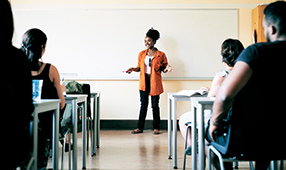For Jocelyn Martin, good classroom organization is simply part of effective teaching. A special education teacher, Martin considers everything from poster placement to the spaces between desks to meet the varying needs in her classroom.
“If the room is disorganized, the whole class is disorganized,” says Martin. “If it’s a clean, organized space, the kids are definitely more receptive to learning.”
Education blogger Charity Preston likens an organized classroom to a well-oiled machine. “If a student sees a teacher who has specific routines and consistently straightens the room in a specific way each time, they begin to see patterns in how to time manage and solve problems,” says Preston, who maintains the Organized Classroom blog.
Here are six tips to get you on your way to your own effective, organized classroom:
1. Arrange desks strategically. Ask yourself what your students will be doing in your classroom. If you favor small group work, consider tables. Martin uses a U-shaped table for her reading group, but the format doesn’t work for her math students, so she also arranges desks in two rows, angled in front of the Promethean board. This helps focus her math students, one of whom has vision impairments that make it essential that he is close to the board.
2. Create optimal student flow. Make sure the flow of the space follows the flow of the day. If students move from reading to math centers, for example, then the layout of your room should follow that order. For primary students, organize centers for math, reading and writing, using round tables if there’s room, or bulletin boards and color-coded and labeled pocket folders if you’re tight on space. Keep similar materials, such as art supplies or math manipulatives, together where they will be used. And make sure you have good line of sight. “It’s important for you to be able to clearly see all the students easily,” says Jessica Meacham, a first-grade teacher in Door County, Wisconsin, who maintains her classroom organization website Mrs. Meacham’s Classroom Snapshots.
3. Manage materials effectively. Preston suggests that teachers organize papers using a simple “in” and “out” basket system for each class or period. When you are ready to grade the papers, grab the basket. She also recommends using labels everywhere—on cubbies, bookshelves, bins and folders—to make it easy to find curricular items when you need them for a lesson. For student materials, Martin keeps baskets of paper, sharpened pencils and big erasers to cut down on student time locating them. Plus, she says, a student with ADHD can quickly get off task by the sound of the pencil sharpener.
4. Buy what you need, toss what you don’t. Look around your room to see which materials are broken, old or useless, and throw them out, Meacham advises. This not only frees up space, but also tells you what you need to purchase, she says. For help selecting materials, try online teacher suppliers.
5. Make your walls do some work. Use your walls to create bulletin boards for student work and curricular supports. Martin keeps a word wall on the chalkboard and puts up posters with math supports where her students can easily access them during instruction. Teachers often are required to post certain items, so make sure you place things where they can be seen when they need to be seen. If you’re tight on space, put student work outside the classroom where parents and other teachers and students can view them.
6. Organize your online resources. Store lesson plan ideas, instructional websites, and even electronic copies of worksheets using an organizational site such as Livebinders.com, or a desktop application such as Evernote. For iPad users, apps such as TeacherKit can organize lessons and grades. Preston and Meacham also use Pinterest to post curricular materials and ideas for classroom organization and also draw inspiration from others.
The bottom line: Whether you’re just getting started or you’re looking for a reboot, it’s essential to consider what makes the most sense to your class and your instructional style, Meacham says. Evaluate your organization at least once during the school year, and be prepared to tweak it for the next set of students. “Being reflective about your classroom organization is critical,” Meacham says. “If something is not working, fix it right away.”












